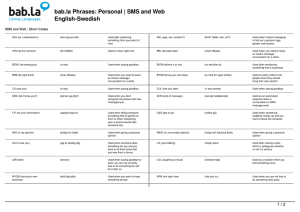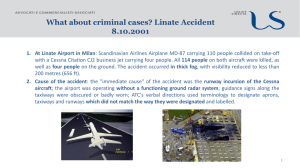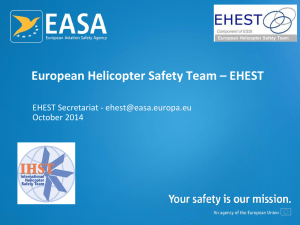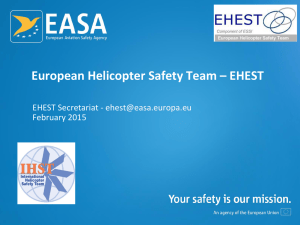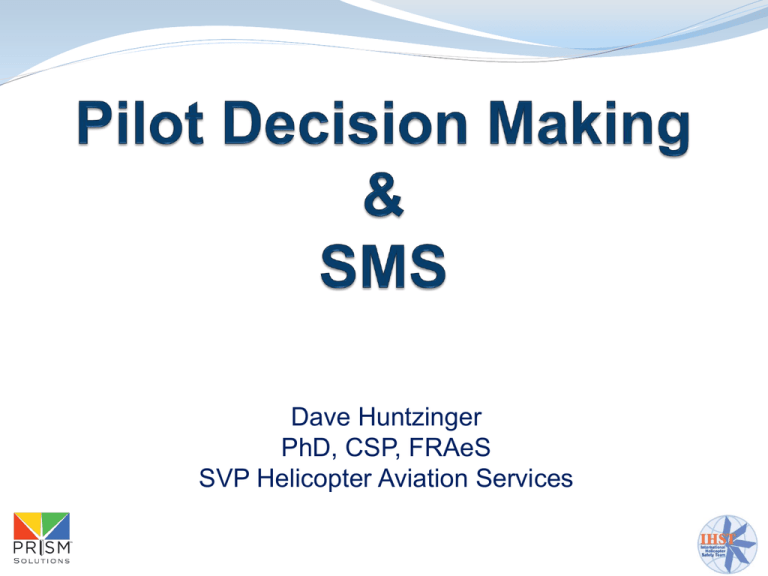
Dave Huntzinger
PhD, CSP, FRAeS
SVP Helicopter Aviation Services
Overview
Statistics
IHST / EHEST Data
Accident Examples
Decision Making Theory
Pre Departure Risk Assessment
SMS and Decision Making
Summary
Objectives
Know that…
Decision Making is part of the accident chain
There are two types of Decision Making theories
with different characteristics
Pre-flight RAs are excellent DM tool
Mission critical decisions can be pre-planned
Use RAs as long term metric
Know that the RW community is different when
it comes to RAs
IHST / EHEST Activities
Goal (by 2016):
Reduce accidents worldwide by 80%
Method
Analyze accidents for common causes
JHSAT
Implement strategies to eliminate same
JHSI T
Products
Toolkits provided free of charge
SMS, Training, Risk Assessment, HFDM, Mx
D-V-E DVD
Pilot Leaflet (DVE, LTE, Rollover, Vortex Ring State)
(www.ihst.org)
(www.easa.europa.eu/essi/ehest)
IHST Data
Study analyzed 523 accidents in 2000, 2001 & 2006
Contributing Factors
Pilot Judgment & Actions
……………. 84%
Data Issues
.…………… 73%
Safety Management
.…………… 43%
Ground Duties
.…………… 37%
Pilot Situation Awareness
.…………… 31%
Part / System Failure
.…………… 28%
Maintenance
.…………… 20%
Mission Risk
.…………… 19%
EHEST Study
Study analyzed 311 accidents in
Pilot Judgment & Actions
Safety Management
Ground Duties
Data Issues
Pilot Situation Awareness
Mission Risk
Part / System Failure
Maintenance
2000 ~ 2005
68%
52%
40%
37%
34%
28%
22%
14%
IHST
84%
43%
37%
73%
31%
19%
28%
20%
Accident # 1
The Aircraft
Single pilot, twin engine
NVG capable
The Pilot
Ratings & hours unknown
NVG trained
The Environment
Day VMC then Night IMC
Accident #1
The Flight
Pick up hiker from mountain
VFR flight plan
The Accident
Controlled flight into terrain
Pilot, hiker killed
Spotter survived
Accident #2
The Aircraft
Single pilot, twin engine
IFR equipped w/ autopilot
NVG status unknown
The Pilot
Commercial, Instrument Helicopter
15+ years in area
8100 hours TPT
The Environment
Night VFR then Night (2100L) IMC
Light Rain, Mist, Fog
Accident #2
The Flight
Already offloaded patient
Repositioning to base
Radar track at 800’ agl
The Accident
Controlled flight into water
Debris path 70’ long by 160’ wide (at 525’ deep)
All major components accounted for at site
Aircraft broke up
Pilot, two flight nurses killed
Accident #3
The Aircraft
Single pilot, twin engine
IFR equipped w/ autopilot and coupled approach mode
NVG capable but not in use, no TAWS
The Pilot
Commercial, Instrument Helicopter
IFR qualified but not proficient
5200 hours TPT
The Environment
Night VFR then Night (2400L) IMC
Fog
Accident #3
The Flight
Diverting for weather to offload patient
Called Approach for radar vectors to ILS
On CL, GS, RoD increased from 500 fpm to 2000+
No level off at either MDA (LOC or ILS)
The Accident
On centerline 3 nm north of runway
Impact 80’ tree, debris path 164’ long
All major components accounted for at site
Aircraft broke up
Pilot, two medics, one patient killed
One survivor (patient)
(50m)
Accidents Summary
Common elements
(in no particular order)
Single pilot
Instrument rated
Aircraft in good working order
Weather started out OK, but went down quickly
Decision to continue
A/C capability not fully used (autopilot)
Controlled flight into surface
Nearly all killed
Decision Making Theory
Analytical Decision Making
Ideal for the following conditions
clear goal or outcome
plenty of time
all conditions, factors are known
From this, the decision maker can
develop wide range of options
evaluate and compare options
choose the optimal path
Decision Making Theory
Analytical Methods Example
D detect
the change
E estimate
need to react
C choose
desirable outcome
I
identify
actions to manage change
D do
take action
E evaluate
effect on correcting situation
Other aviation related analytical methods include
IMSAFE, CARE, SADIE, TEAM, PAVE, 5Ps, 3Ss…
Do you use these? When? Which one(s)?
Decision Making Theory
Analytical Method Characteristics
Structured
Time consuming
Process breaks down with stress, limited time
Analytical Methods
Deliberate & thoughtful
Better suited to
Aircraft design
Flight planning
Aircraft purchasing
Decision Making Theory
Intuitive Methods
Fast
Simple
Memory based
Work with limited information
Option chosen probably OK, but not optimal
Better suited to real time decision making (flying)
and other dynamic, fast paced situations
car driving, sports, combat
Decision Making Theory
Naturalistic Decision Making (one intuitive DM process)
Used in complex, fast paced situations
Key features
series of decisions
interdependent
(one affects the other)
conditions constantly changing
independently and as result of your action
real time decision making (not planning)
goals not well defined
could be competing goals (safety vs …)
decision maker is
knowledgeable, experienced & professional
(Peter Simpson)
Decision Making Theory
Naturalistic Decision Making
Not so much a method as the way we actually do things…
Step 1:
Situation Assessment
(SA)
Problem definition
identify
problem
goal(s)
information sources needed to succeed
prioritize incoming information
disregard (“park”) other stuff
Risk assessment
severity & probability
Time available
Decision Making Theory
Naturalistic Decision Making
Step 2:
Course of Action (CoA)
Potential solutions considered (in order of use)
rule based one solution; procedure
memory based; experience, sim, training
choice
options; this or that will work
maybe memory but not always
creative
nothing obvious
consider similar situations for solution
Simulation
mental test of potential solutions and outcomes
Act
Decision Making Types
Factor
Comparison
Analytical
Naturalistic
Goals
Pace (speed)
Time available
Stakes
Data
Environment
Participants
Decisions
Solution
defined
slow
plenty
low
complete
known
many
as needed
optimal
varied
fast
limited
high
incomplete
changeable
few
immediate
OK
Naturalistic DM Errors
Two basic areas
Situation Assessment errors
poor understanding of situation
poor risk assessment
misjudge time available
Course of Action errors
right rule, wrong time
right rule, poor application
choose wrong procedure or option
In general
More information, experience helps
recognize the situation & solutions
Naturalistic DM Errors
Contributing Factor: Motivations and Rationales
Often competing goals
Customer
Financial
Company
Personal
Peers
Duty
Rationales
Justify the decision
Macho
Invincible
Impulsive
Resignation
Anti authority
Management must
eliminate competing goals => Safety is primary goal
educate against rationales => Procedural compliance
is key
Decision Making Errors
People tend to..
Under estimate the situation
Over estimate their ability
25
SMS Basics
“Four Pillars of SMS”
Safety Policy
Safety Risk Management
Safety Assurance
Safety Promotion
ICAO Doc 9859, 2nd Edition, 2008
Ref:
26
FAA AC 120-92A
Safety Management Systems
Safety Risk Management
Risk Assessment
Hazard Identification Methods
Mitigation
Safety Management Systems
Safety Risk Management
Hazard Identification methods
Audits
Hazard reports
Safety surveys
Pre Departure Risk Assessments
Pre Flight Risk Assessment
Many to choose from
FAA
Vendors
Operators
Industry groups
HAI web site
www.rotor.com/FRA
Most have the same categories
Environment / Wx, Crew / HF, Operation / Flight, Aircraft
SMS
Environment
Flight
SMS
RISK
ASSESSMENT
Ops
Human Factors
Some of this can
be done at start
of shift
Helicopter
Directions for use
30
SMS
SMS
Major
hazard
Run checklist for
mission + return
Tally scores and
check risk value
Green = Go
Risk value
Risk range
But major hazard
needs mitigation
31
SMS
Mitigation:
Obstacles
SMS
Take credit on
first page
- 5 points
Risk was 15
Now 10
© Eurocopter rights reserved
32
SMS
Mitigation
codes
Points
deducted
New risk
value
© Eurocopter rights reserved
33
SMS
Different
conditions…
Mitigation
required
Weather
is worse…
What can we
fix right now?
Pilot is less
experienced
Aircraft less
capable
Higher risk
value
© Eurocopter rights reserved
34
SMS
Mitigation:
1. Obstacles
2. Repair
SMS
Take credit
on first page
- 7 points
Risk was 30
Now 23
© Eurocopter rights reserved
35
SMS
Mitigation
details
from
page 2
SMS
>20 with
Mitigation.
Waiver
required !
New risk
score
© Eurocopter rights reserved
36
Final step on RA
SMS
If conditions get
worse, then what?
Pre-approved
A chance to think it through in a no-threat environment
© Eurocopter rights reserved
37
SMS and Decision Making
Review of DM process…
Analytical methods…
Ultimate goal in mind (safety)
No threats at hand
Time is not an issue
Can think ahead
Consult references, others
Review multiple options
Select optimum solutions
Better suited to the planning process, so…
Do it before flying…
Solutions may be the same on many flights
Repeat is OK; it builds DM experience and consensus
Experience is key element of good Naturalistic DM (SA & CoA)
These serve as the limits or boundaries of what you can do
Maybe not a lot
of planning
time but better
than while
flying
© Eurocopter rights reserved
39
Back to our
RA…
SMS
Waiver
Approved !
Use as briefing
tool for crew
Waiver
Requested
Keep RA with
other paperwork
Time to go
flying…
© Eurocopter rights reserved
40
Decision Making
Points shown here for
discussion. We do NOT pull
out the RA and recalculate
Now you are flying...
Patient is on board
Condition is critical and getting worse
Flight plan is changing…
Weather is getting worse (300’ and 1 nm)
Destination hospital is now closed for weather
Diverting to new hospital; unknown to you
At 90 % limit for fuel burn
Duty day extended to Back of the Clock
Previous total: 23 + 12 = 35
Risk matrix ORANGE band 20 ~ 39
goes RED at 40
2>4
2>4
0>2
0>1
0>5
+ 12
Decision Making
Cascading changes
things are backing up
Conditions deteriorating but still manageable
However, fatigue is setting in
still have to land, refuel and return
you are busy with radio, GPS, fuel planning…
not the ideal time to make decisions…
But this is exactly when a decision is needed
(Situation Awareness)
You reached your preset limits
Decision Making
What to do? (Course of Action)
You are now well into the ORANGE band
One more item puts you in the RED…
Land?
Land and transfer patient?
Keep going?
Previous RA planning…
a) weather below FOM minimums LAND !
b) 2 or more conditions changed for the worse
Coord with ground unit; guide them to you
LAND !
Decision Making
It is recognized you cannot pre-plan for everything
However we know that
Real time decisions are hard to get right
As conditions get worse, risks increase
Recognizing the change (SA) is key, then
Execute the well known, pre-planned decision (CoA)
Under SMS…
We still “Plan the Flight, Fly the Plan”
But, we also, under certain circumstances,
“Plan to Land, Land to Plan”
Accident #1 NTSB Report
The National Transportation Safety Board
determines that the probable cause of this accident
was the pilot’s decision to take off from a remote,
mountainous landing site in dark (moonless), night,
windy, instrument meteorological conditions.
Contributing to the accident were an organizational
culture that prioritized mission execution over
aviation safety and the pilot’s fatigue, self-induced
pressure to conduct the flight, and situational stress.
Also contributing to the accident were
deficiencies in the [operator’s] safety-related
policies, including lack of a requirement for a
risk assessment at any point during the
mission…
Decision making
Competing goals
No Risk Assessment
Accidents Revisited
Three fatal CFIT accidents discussed previously…
VFR at beginning of flight
Then deteriorated to IMC
Decision made to continue
Could use aircraft automation
But, decided to continue visually
Using this RA & DM briefing sheet
Weather below FOM minimums: Land & Wait
(Or, if IFR capable, go IFR)
Fables !
© Eurocopter rights reserved
47
The Camel
The camel, kneeling, waited patiently for his master to finish loading
him. One sack, two sacks, three, four…
“When is he going to stop?” the camel said to himself.
Finally, the man clicked his tongue and the camel stood up.
“Let us go,” said the master, pulling on the bridle. But the camel did
not move.
“Come on!” cried the man, jerking the rope. But the camel dug in
his feet and stayed where he was.
“I see,” said his master, and with a sigh he took two sacks down
from the camel’s back.
“That, I think, is a fair weight,” murmured the camel to himself, and
at once began to move.
They walked all day at a good speed and the man thought they would
be able to reach the village. But, at a certain point the camel
stopped.
“Courage,” said the master, “only a few more miles and we are there.”
The camel’s only response was to lie down on the ground.
“My legs tell me,” he said to himself, “that we have walked enough for
today.”
And the man was obliged to unload and to camp beside the camel in
the desert.
Fables of Leonardo Da Vinci, Hubbard Press, 1973.
Summary
Decision making errors are real
Well known part of accident causation
Decision making is a dynamic activity
Successful decision making is difficult “on the go”
SMS activities can facilitate successful decision making
The RA is a good tool for that
Works as an excellent crew briefing tool
We can modify the way we make decisions
Try to make at least some of them in advance
if this happens, then I will do that…
(May need separate
one for X-country)
Consider
Morning
or Afternoon
Modify
Modify
Different
equipment
Fire Fighting
Morning
No night ops
No IFR ops
Fire base
Dip pond
Days ON
(more days,
more points)
Longline
Bambi bucket
(Inspected)
51
Implementation Question
How to get this to (past) the pilots?
More than a box checking exercise…
Builds situational assessment
Good briefing tool
Gives you an (honest) out
Defends you if things go wrong
Past management?
Long term improvements
System wide situational assessment
52
Closing Comments
What to do with all those Risk Assessments?
Risk Assessments NOV 2009
15%
5%
Ops Normal
Mitigate, Waiver
STOP WORK !
80%
53
53
©
Eurocopter
rights
reserved
SMS Tips: Safety Assurance
Pre - Departure Risk Assessment Review
30 days worth
80 in the green
15 in the yellow
05 in the red
What caused risky scores?
Are there systemic factors?
Develop corrective, preventive actions
54
SMS Tips: Safety Assurance
Risk Assessments
Last 6 Months
80
70
60
Ops Normal
50
Waiver, Mitigate
40
STOP WORK
30
20
10
0
Jun-09
55
Jul-09
Aug-09
Sep-09
Oct-09
Nov-09
Safety Assurance
This metric shows you are
looking ahead at hazards
reviewing them for trends
tracking efforts at continuous improvement
This is a cornerstone of SMS
Thank You


